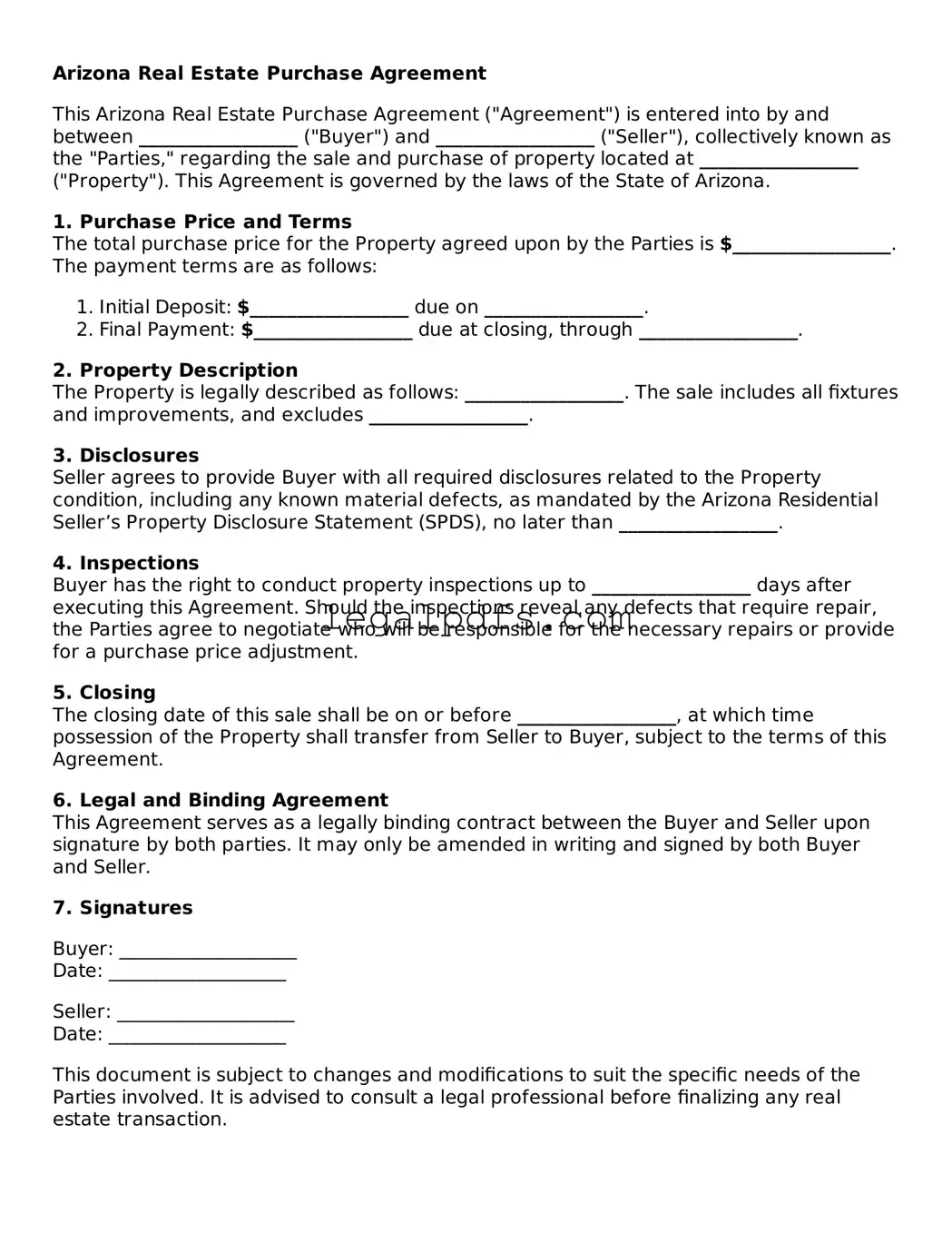What is an Arizona Real Estate Purchase Agreement?
An Arizona Real Estate Purchase Agreement is a legally binding document that outlines the terms and conditions under which property in Arizona is sold and purchased. It details the agreement between the buyer and seller regarding the price, location, condition of the property, and other terms of the sale. This form is essential for the transfer of real estate ownership from the seller to the buyer.
Who needs to sign the Arizona Real Estate Purchase Agreement?
Both the buyer(s) and seller(s) involved in the real estate transaction must sign the Arizona Real Estate Purchase Agreement. In cases where the property is owned or being purchased by more than one party, all parties must sign the agreement to ensure its validity and enforceability.
Is a Real Estate Purchase Agreement enforceable without being notarized in Arizona?
While notarization is not a legal requirement for the enforceability of a real estate purchase agreement in Arizona, it is highly recommended. Notarization can provide an added layer of verification and can be helpful in the event of a dispute or legal challenge regarding the validity of the signatures on the agreement.
Can the terms of the Arizona Real Estate Purchase Agreement be modified after both parties have signed it?
Yes, the terms of the agreement can be modified after signing, but any changes must be in writing and signed by both the buyer and seller. Oral agreements or understandings not documented and signed by both parties may not be enforceable.
What happens if either the buyer or seller breaches the Arizona Real Estate Purchase Agreement?
If either party breaches the agreement, the non-breaching party has certain legal remedies available. These can include seeking specific performance, which is a court order requiring the breaching party to fulfill their obligations under the contract, or seeking damages for financial loss incurred due to the breach.
Are there any contingencies that can be included in the Arizona Real Estate Purchase Agreement?
Yes, contingencies are common in real estate purchase agreements, and they provide conditions that must be met for the transaction to proceed. Common contingencies include those for financing, inspections, appraisal, sale of another property, and the review of homeowners’ association rules and regulations.
How does the earnest money deposit work in an Arizona Real Estate Purchase Agreement?
The earnest money deposit is a sum of money that the buyer pays to demonstrate their serious interest in going forward with the purchase. It is typically held in an escrow account and applied to the purchase price at closing. If the sale falls through due to contingencies outlined in the agreement, the deposit may be returned to the buyer. However, if the buyer breaches the agreement without cause, the deposit may be forfeited to the seller.
What disclosures are required by Arizona law to be included in the Real Estate Purchase Agreement?
Arizona law requires certain disclosures to be made by sellers, including disclosing any known material defects about the property. This includes issues with the physical condition of the property, any encumbrances, and whether the property is in a special flood hazard area. Depending on the specifics of the property, additional disclosures regarding lead-based paint, radon gas, or other hazards may also be required.
Can the buyer back out of the Arizona Real Estate Purchase Agreement?
The buyer can back out of the agreement if it includes specific contingencies that are not met, such as securing financing, satisfactory property inspection results, or other conditions detailed in the agreement. If the buyer backs out for reasons not covered by contingencies, they may forfeit their earnest money or face legal action for breach of contract.
How is the closing date determined in the Arizona Real Estate Purchase Agreement?
The closing date, which is when the transfer of property is officially completed, is mutually agreed upon by the buyer and seller and specified in the real estate purchase agreement. This date is often contingent upon certain conditions being met, such as financing approval and completion of inspections. Both parties work towards meeting these conditions by the closing date to ensure the sale proceeds as planned.
